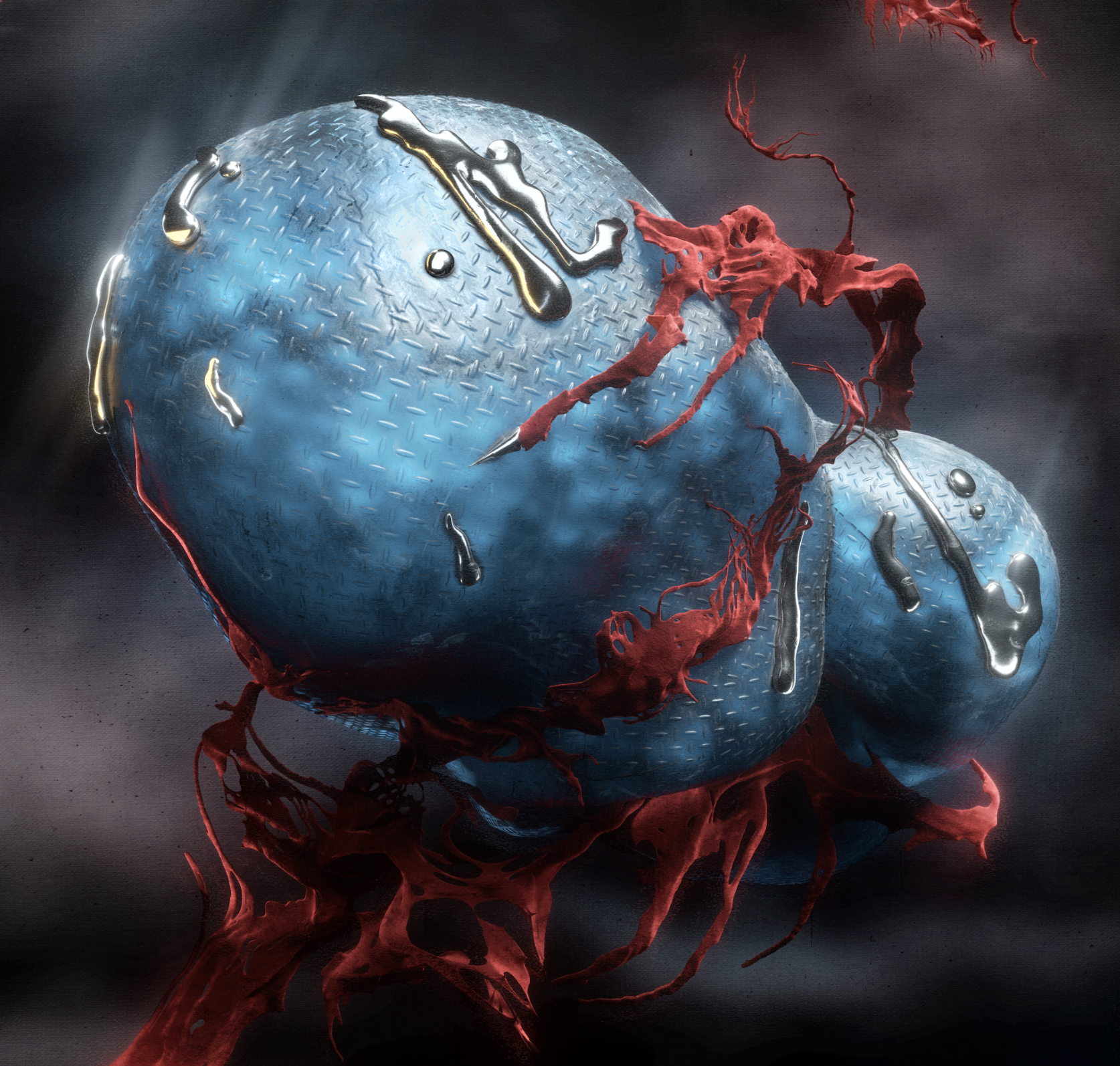Sarah Ann Banks, Alfacenttauri, Irene P Tello, Stacie Ant, Ailin Kertesz, Dominik Nawrocki, Tabitha Swanson, Gondris Cavel, Guillaume Roux, Alexandr Martsynyuk, 530°, Hypereikon & Cristian Anutoiu.
NFT / Art / Design / Culture
Upcoming NFT drops at reloaded.fun
Collective interview with selected Artists from "Reloaded" new curated NFT Marketplace, by TUNICA to talk about NFTs, value, decentralization, and Art politics. Vol.02
What do you find the most enticing about the NFT world?
Sarah Ann Banks / @ssarahbankss: I became interested initially as a new way for digital artists to have funding. Working in this field before the NFT boom, there were so many artists with big ideas and no functional way to monetize them.
@alfacenttauri: Mainly it’s the innovation and the possibility of expanding your social network. It’s also a chance to perceive art from a collective perspective which opens a shared experience that’s full of solidarity, respect, and admiration. Competition is not something I’ve seen here. The NFT enables the chance to reconsider work, like in the sense Nick Srnicek talks about socio-technological and collaborative communities in which divergent identities prevail and work in horizontal and molecular directions.
Irene P Tello / @ip.tello: For me, just the fact that a non-fungible token is a unique digital asset that represents ownership of real-world items like art, video clips, music, and more. Also the technology and medium applied as NFTs use the same blockchain technology that powers cryptocurrencies, but they're not a currency. NFTs are the key to the metaverse. With the digital tokens, people are becoming owners on the internet, instead of simply renters which results in a new exciting paradigm full of new possibilities of investment and business within the digital/virtual universe.
Stacie Ant / whosthereplease: I like the freedom you have in the NFT world. This is a great opportunity for artists to make a name for themselves and bypass traditional institutions such as art galleries, handlers, or any other middlemen who previously had to represent artists to get the proper exposure and find collectors. The NFT world has the potential to give artists power over their own work, ownership, and representation.
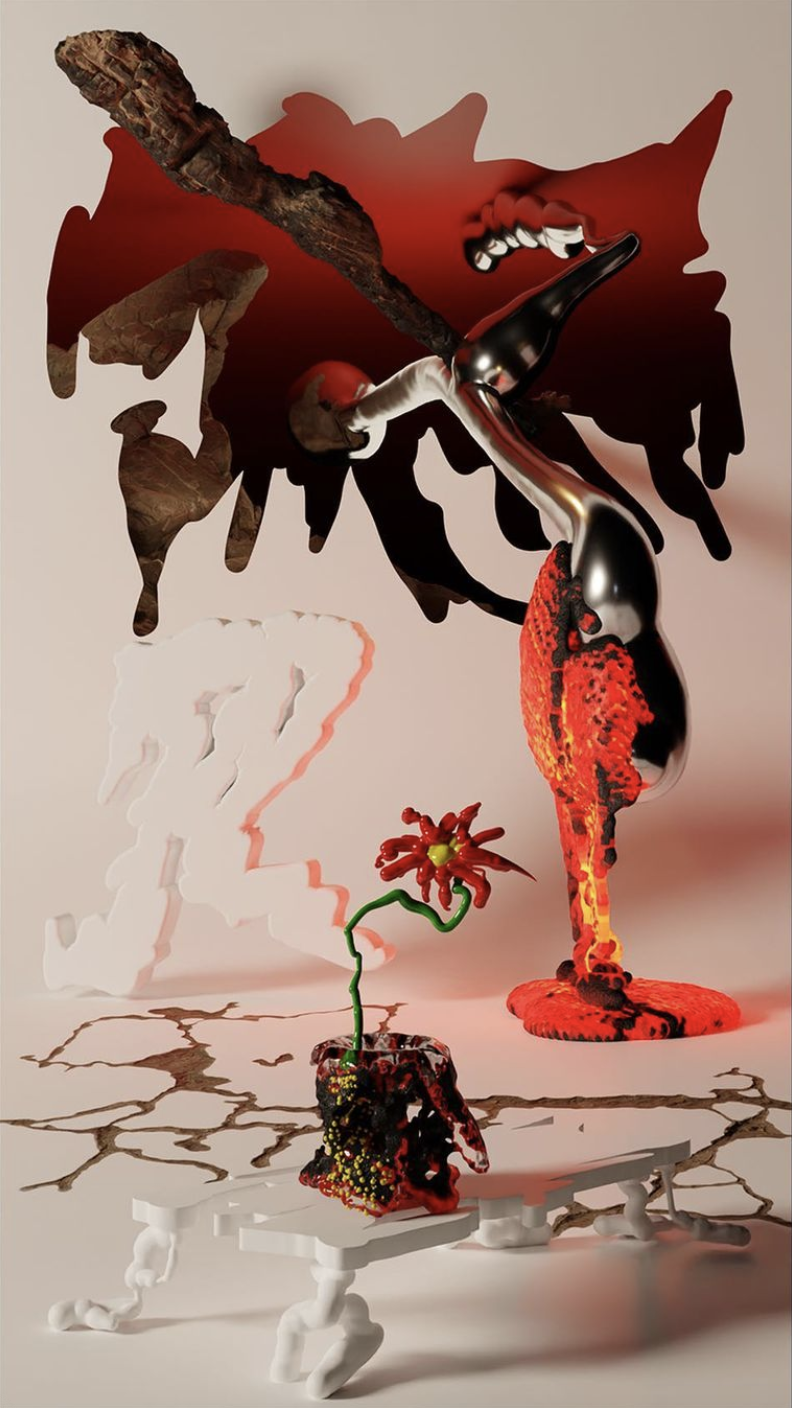
Artwork by Guillaume Roux
Ailin Kertesz / @afr0dita__: To be able to make a living from my art whilst being completely independent. The same applies to the rest of the artists, each one can choose which way to do it, the NFT world is super wide.
Dominik Nawrocki / @sesimen.co:Technology that helps protect copyrights and liberates the possibilities to sell works and “be” in the contemporary art world.
@tabithaswanson_: I enjoy that it’s shaking up current structures and allowing a new way for artists to make a living from their art.
@530degres:Much of our work takes a digital form. We see NFT as an opportunity to sell some of this work, as well as sometimes giving it some purpose. This allows us to develop a more artistic practice in parallel to our work as designers, even though the two are intimately linked in our productions. Finally, there is also a community aspect that can be interesting.
@hypereikon: Participating in a decentralized economy, speculating on the value of digital files, and revealing their cultural impact.
Cristian Anutoiu / @b4cterija:The security of proven authorship within digital media and the arts, and the fact that the NFT market is to some extent still pretty fresh for most artists (including me) and there are still a lot of exploration possibilities within this market.
"Here is the news!!" by Dominik Nawrocki
Audio by Ewa Sadowska
What do you think legitimizes NFT art as art? Do you think there is and/or should be a separation of the NFT art market from the art market?
Sarah Ann Banks / @ssarahbankss: I don't think there should be a separation. I think digital art was always legitimate, but difficult for collectors to understand. NFTs act as a bridge from traditional art worlds to the digital. Hopefully it stays that way!
@alfacenttauri: This is quite hard to answer lol. I wouldn't dare to summarize this long-standing discussion and I don’t wanna give a doctrinaire answer; I’m no art critic, but I do believe the legitimation of art depends on the sole meaning the creator puts out there, even though, I know that this often leads to an ambiguous and indeterminate position. But that’s what I think, just like what Baudrillard says in The Conspiracy of Art, “any search for objective or subjective expression”... and ultimately, yes, I do believe we should avoid becoming what elite art markets have become and prevent money laundering and financial speculation from happening; it’s important to watch out for digital colonization.
Irene P Tello / @ip.tello: In my opinion, it’s mainly the difference/shift of medium. Traditional art is more linked to the gallery business model, but digital art owns a different language, format, and medium, and therefore, a different business model – more versatile and adapted to the new Internet audiences. In a world where digital formats have a huge presence and dominance – I would say that the art market should be always in the vanguard, adapting to what is coming up ahead, but also to new business and new forms of exchange integrating a common and universal market system.
Stacie Ant / whosthereplease: I think that there will always be a demand for physical art, such as it’s seen in the traditional art world, but NFT is a way for digital artists to finally be recognized as fine artists whose work can be valued and profitable outside commercial projects.
Ailin Kertesz / @afr0dita__: Tbh this is actually a talk that I usually have with friends, and I don't have a definite or closed opinion. At the moment I think that it is the artistic community itself that recognizes an nft as a work of art and its value is a reflection of that recognition. I believe that crypto art is a language in itself with its [own] appreciation and condemnations. On the other hand, I think there is already an important separation which is that an nft artist doesn't need an intermediary to be able to sell her/his work.
"Radar Drome Platform" by 530 Degres Agency
Dominik Nawrocki / @sesimen.co: For me, it is the opinion of both, the recipient reception along with the creator’s intention. I don’t know if there is or should be a separation of the NFT art market and the “official” one. But it looks like some of the art institutions are now trying to catch up and involve themselves in NFT.
@tabithaswanson_: I think art and NFT art can be seen differently, but it’s too subjective and hard to define what is “art” and what isn’t, so I’m not sure we can separate them. Some people collect NFTs because they like them, some collect so they can flip them and sell them for a profit – this is parallel with the previously known art world as well.
@alexandr.martsynyuk: I don't think any form of art needs to be legitimized. People dig pieces that bring them emotions and they want to own it. I think it 's separated from the beginning, by definition of the subject. At the same time I don’t think that people involved in big non-digital marketplaces have missed the opportunity to speculate with NFT pieces.
@530degres: For us, NFT art is legitimate as art. We think that there shouldn’t necessarily be a separation between these two markets even if they take different forms. Many artists from the traditional art market have also entered this market. The main difference is that the NFT art market is much more accessible because it’s free of intermediaries. It leaves a wider choice to the buyers as well as the possibility of discovering new artists, although these last ones don’t always benefit exposure.
@hypereikon: We think “crypto art” is legitimized by the artists participating in the blockchain along with the communities that intercollectively grow around it. We do believe that there are great differences between these markets though. The traditional art market is well characterized by its gatekeeping practices and difficulty to access, in our case as Latin American artists, it’s even worse. Yet, the traditional art markets contrast against what open access NFTs platforms have delivered: bringing the possibility of accessing an international, anonymous, encrypted artistic market towards an infrastructure of digital archive and authorship. There are of course interesting connections between both markets, but it is necessary to point out that these exist particularly since NFTs have shaken up many possibilities. It is because of the failure of digital art in traditional art spaces that crypto art becomes relevant.
"ANGR MNGMNT" by Oleksandr Martsynyuk
Do you consider the NFT market as exogenous of the traditional art market, or do you see it as more of an evolution of such?
Sarah Ann Banks / @ssarahbankss: I think it's definitely an evolution, especially with more and more of our lives being at home, it only makes sense that the next steps are to fully digitally buy and sell artworks.
@alfacenttauri: I think it can be both. If things continue like they are right now, then maybe the digital art market will ultimately become nothing more than an extension of traditional ones; but if we do manage to exclude the attempts of appropriation from megacorporations, then maybe we can discern elitist, speculative and art-flawed markets.
Irene P Tello / @ip.tello: While the terms crypto, NFT, and metaverse may seem like part of a science fiction novel, they are actually part of a digital revolution that is shaping the future of money and the way we do business. It is no longer a world solely for gamers and social media profiles, big companies are now involved and are bringing more of their kind into this space. So in my opinion there’s obviously a next level in the evolution of things that will bring new possibilities of exchange and ownership, and it could be easily compared to the ancient processes of exchange in the street food markets (barter) or merchandise industry.
Stacie Ant / whosthereplease: When the NFT market first became a market, I saw a lot of imagery that I would not really consider artwork. It was more meme-oriented in my opinion, and I think people saw it more as currency rather than art. But now, many platforms hand-select artists and participants, and people finally begin to care about the quality of the piece, the aesthetic and conceptual value of NFTs. So in some ways, NFT is a new hybrid of type of currency, investment, and art collection for the purpose of artistic appreciation.
"Paradisia" by Alfa Centtauri
Dominik Nawrocki / @sesimen.co: Hard to tell, I’m not really aware of the very beginnings but overall it seems to me more like an evolution of things. There is still some resemblance to the traditional market like ways to join certain platforms, being featured by the marketplace editorial stuff, etc.
@tabithaswanson_: Hmm, good question, maybe an evolution, but perhaps also a bit of convergent evolution? Similar to the Rhinesuchus (a now extinct amphibian) and modern day crocodiles.
@gondris_cavel: As an evolution of the feelings of the human race without pretension.
Guillaume Roux / @rouxcoucou: I think the NFT market is complementary, it is an answer to an explosion of digital culture/art.
@alexandr.martsynyuk: I consider it as a grandchild with fresh beeping gadgets connected worldwide.
@hypereikon: Totally exogenous, and involved in our contemporary living on the internet. Very embodied in the ideas of not wanting to be like the traditional art market and wanting to disinherit habits from it.
What is interesting is to open new forms of dissemination, management and artistic market, but which in turn must be questioned critically.
Cristian Anutoiu / @b4cterija: I see the NFT market as an extension of some sorts to the traditional art market, that is functioning on its own entity and reflecting the “traditional art market“ in many ways, but also within its own bubble.
"ˏˋIIOOII ́ˎ" by Hypereikon
Before the blockchain, different markets for digital art had been established, in which images, simulations, or experiences were exhibited and whose rights could be owned. Digital art collection precedes the blockchain. Is there something that you consider groundbreaking about NFTs in the way it challenges the traditional sense of art ownership?
Sarah Ann Banks / @ssarahbankss: It definitely lessened the tension caused by purchasing digital work. In the past I've known artists to sell a computer and monitor with a work just to confirm the collector would be able to have it in the right form. Now it's a much easier pathway. I think that was initially the most revolutionary aspect to me, that people now suddenly have accepted that the work was online instead of forcing it into reality.
@alfacenttauri: The establishment of blockchain and smart contracts have allowed defining the ownership of art pieces as intangible assets. What’s interesting in this is the expansion that digital contracts may have for other areas such as music. The other day I was reading about a group from the scientific community that was looking at the possibility of managing a DAO to finance future research.
There are so many possibilities. DAOs for example, being collaborative and nonhierarchical structures, can become the future of social fabrics as strategic pillars of molecular ecosystems of political contestation. This is for me the most innovative part of it all.
The collective selling or acquisition of art in DAOs have determined purposes — even political purposes. Possessing art without it involving some sort of luxury is not something that the traditional art market enables.
Stacie Ant / whosthereplease: NFTs make the purchase of digital art a lot more accessible. It is much easier to purchase artwork on an NFT market than it is to purchase a digital artist’s installation to be set up in your home. And even so, I would argue that digital art did not sell as easily as traditional mediums, NFTs have really turned that around.
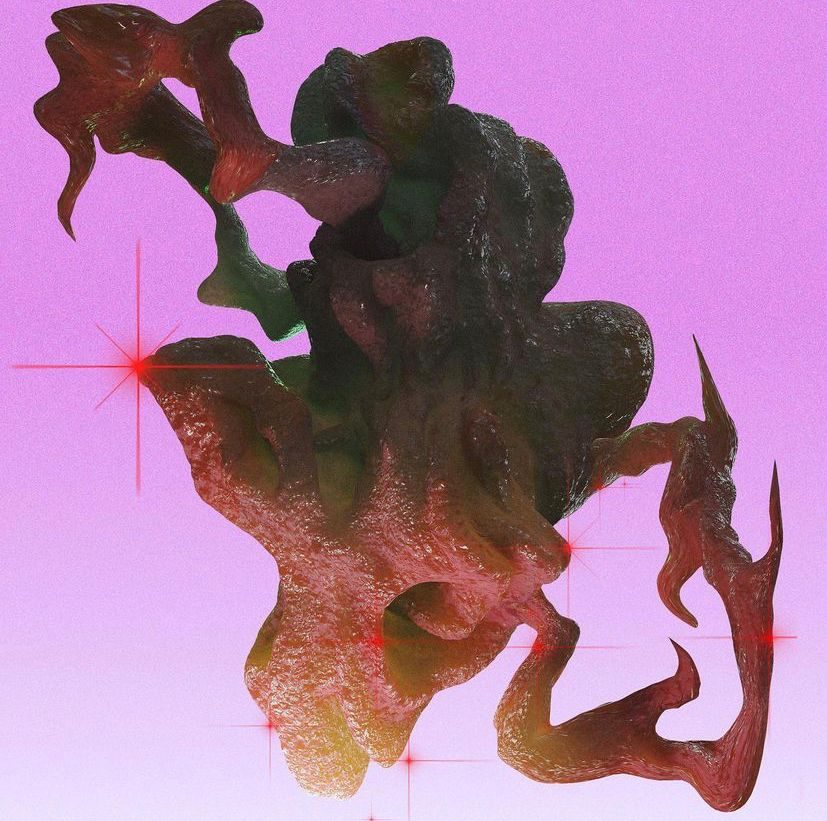
Artwork by Cristian Anutoiu
Ailin Kertesz / @afr0dita__: NFTs are an excellent solution to ensure the uniqueness and origin of physical and digital assets in a secure and transparent way. Also, in case the collector wants to resell an artwork, the artist is going to receive royalties from that sale. So yes, change things a lot.
Dominik Nawrocki / @sesimen.co: As I’ve mentioned, it’s a matter of technology used to protect the creator and the owner. It’s commonly considered to be one of the safest ways to carry out transactions and I think it’s also strongly based on the social contract. For the collector, it gives certainty to hold the original work and personally I think also gives the creator a feeling of being protected by this social contract.
Guillaume Roux / @rouxcoucou: I think it is the same as before, NFT is just a digital contract giving the artist the possibility to emancipate from galleries and be more independent.
@alexandr.martsynyuk: You can mint anything as a NFT and have success, that is groundbreaking. You still have some sort of curation on crypto art platforms. – On the other hand, images like "Disaster Girl" are sold for millions. Memes have been part of our culture for a long time now, but I don't remember them being sold for such value in traditional marketplaces.
@530degres: For us it doesn’t make much difference in terms of ownership in a literal sense. However, we believe that NFT has been popularized because blockchain technology goes beyond the art world. Moreover, as we said before, NFT is a transaction modality that allows us to dispense with the traditional art market players and makes it less elitist. The revolutionary aspect is, in our opinion, mainly in the access to artists to a sales platform. It’s mainly the digital finality of the works which shakes the concept of property, it doesn’t matter if it passes by the NFT or by another market of the digital art.
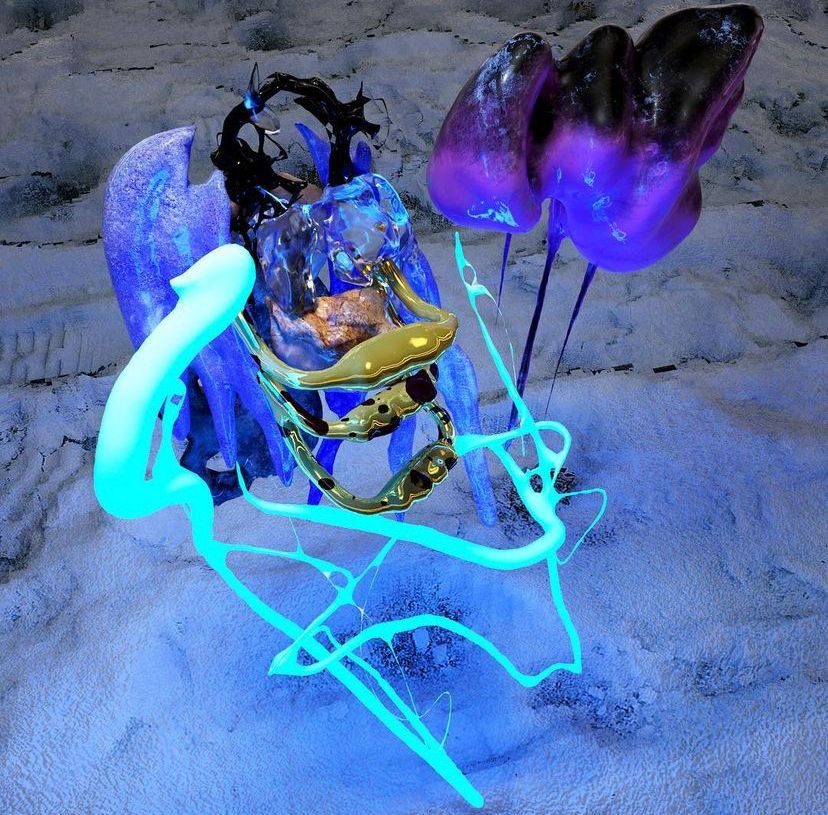
Artwork by Guillaume Roux
There is a common argument about NFTs and its role in the decentralization of the art market. Even if blockchain technology had the potential to democratize art, whatever that means, some artists and critics find this idea misleading and redundant. What is your stance in regard to this?
Sarah Ann Banks / @ssarahbankss: Even though decentralization seems like a futuristic push, there's still a lot of opportunity for all of this technology to be used negatively. I think we just need to monitor who is operating for positive reasons and be aware of scams and cash grabs that sort of ruin the advancements being made.
Stacie Ant / whosthereplease: There are a lot of problems with NFTs, in my opinion. A lot of people still see it as a "get rich quick" scheme and don't understand how much time needs to go into promotion, planning, and finding the right platform with appropriate collectors. Even gas fees to mint artworks are so high that not every artist can afford to use popular NFT platforms. I think that NFTs should be viewed as new technology - one that we, as a society, are still trying to fit into our understanding of both art and investment. But I undoubtedly believe that the benefits of this technology outweigh the negatives and it is the future of digital art.
Ailin Kertesz / @afr0dita__: Of course I agree with the idea of "democracy", but sometimes it can be a little theoretical concept that in practice is always partial. It applies to everything. Honestly, talking about democratic art in economic terms seems quite misleading to me. Anyway, three crazy monkeys running the art market were already a bit old.
Dominik Nawrocki / @sesimen.co: I don’t think there’s anything wrong about decentralization of anything. From the history of my country, I know that centralization leads to serious, in that case, economical distortions. Still, it all depends on how the NFT market will evolve and remain easily accessible for creators.
"Ikebana" by Irene P Tello
@tabithaswanson_: I can understand both viewpoints, though I’m not sure if it matters. We’re all just trying to make a living and many artists have classically had a hard time having their work valued and finding a way to make a living from their artistic vision without having to chase down clients for payment. If NFTs are a way for some of them to do it, then power to them.
@gondris_cavel: There is always a market game, yes, but I think the search for the truth must always prevail. She will dictate the rules within each one.
Guillaume Roux / @rouxcoucou: I don't think blockchain democratizes art, for me it is more democratizing digital culture to the eyes of the art world.
@530degres: It’s true that the NFT participates in a certain decentralization of the art market. However, we think that the term «democratize art» is a bit too strong. The concept of the NFT indeed allows any creator to propose his work for sale, and thus an access to the art market for all. That said the NFT remains for some an object of speculation rather than a means of supporting the creators.
@hypereikon: Access to a speculative market and being able to participate in it as curator and collector has been democratized. The opportunity to make a living from art is democratized but access, storage and sharing of digital files is not, that is inherent to the internet.
"Shoe" by Tabitha Swanson
We’ve heard people argue that so far the crypto aspect of NFT art is more dominant than the creative aspect of it. You can see this with NFT art whose role in the market is more as a “collectible” rather than unique with an aesthetic-sensitive value. Where do you see crypto art heading in this matter? Is the distinction of collectible images and pieces of art even worth pointing out still?
Sarah Ann Banks / @ssarahbankss: I definitely prefer more individualized works. I think that is the most positive aspect of these platforms. On the other hand, I don't necessarily see these collectible things as a negative, more so a by-product.
Stacie Ant / whosthereplease: I think that it’s important to keep in mind that people who have a lot of Ethereum are not necessarily your traditional art collectors. This is why it is unnecessary to look at NFTs as mere art. From what I understand, for many, the thrill of collecting NFTs is the actual collection aspect of it, like stamps or rare comic issues.
Ailin Kertesz / @afr0dita__: From the beginning, I disagree with this affirmation: "so far the crypto aspect of NFT art is more dominant than the creative aspect of it." In fact, I think that's something that can happen in every possible market. Making digital art and then tokenizing it doesn't mean that the emotional value of the work is reduced to the market in which the work is inserted. Also, there are amazing collectibles too.
Dominik Nawrocki / @sesimen.co: There is a distinction of genres in “traditional” art so why not do it in NFT. It’s a natural process of assigning things to certain collections. I don’t think the aesthetic aspect is more “arty” than technological.
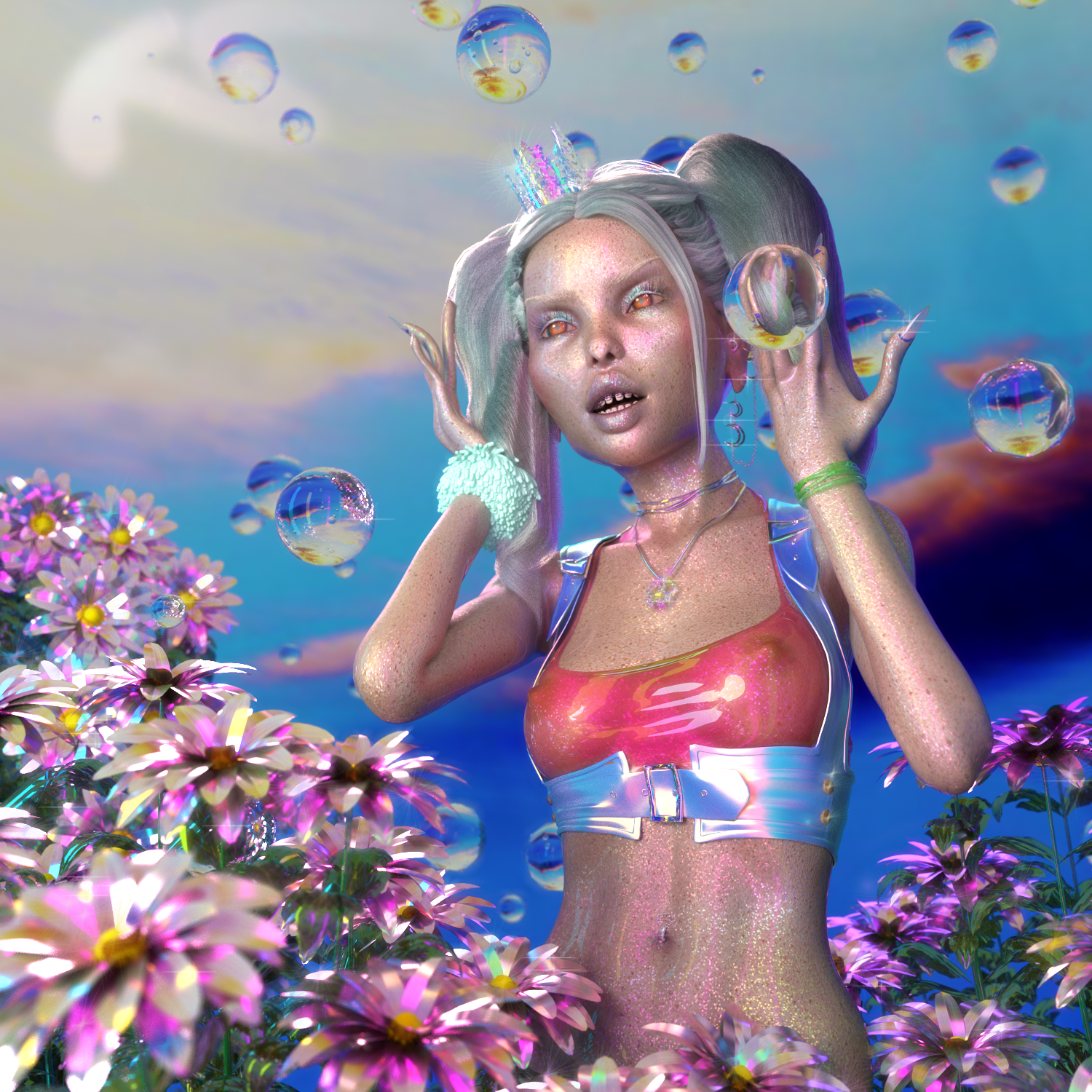
"Chrome Queen" by Stacie Ant
@tabithaswanson_: I think “good, thoughtful art” and “NFT collectibles” are two different terms in my head that I try not to conflate.
Guillaume Roux / @rouxcoucou: I think collectibles and art pieces should be seen the same way they’re seen in the real world. Some collectibles are art-related like a 50ex lithography, which would be considered as art, but most of them are really like pokemon cards, which I think is not really art.
@alexandr.martsynyuk: I like the fantasy touch of Magic cards, but I won't spend as much time looking at them as I spend looking at Viktor Timofeev's drawings, for example. This distinction or the absence of it will reveal itself naturally with time. Just like it was with “low art” and “high art” (now mostly an abandoned concept). For now, I see NFT collectibles as crypto speculation with a profit intention.
@530degres: We believe that we are currently facing a certain frenesí concerning the collection of NFT. We would like to see it subside over time so that the focus is on the quality of the work and the honesty of the process rather than on the commercial and speculative side. This somewhat naive point of view has probably been shared for a long time by artists concerning the classic art market. In any case, such a change can only come from the buyer himself, not from the system or concept of sale.
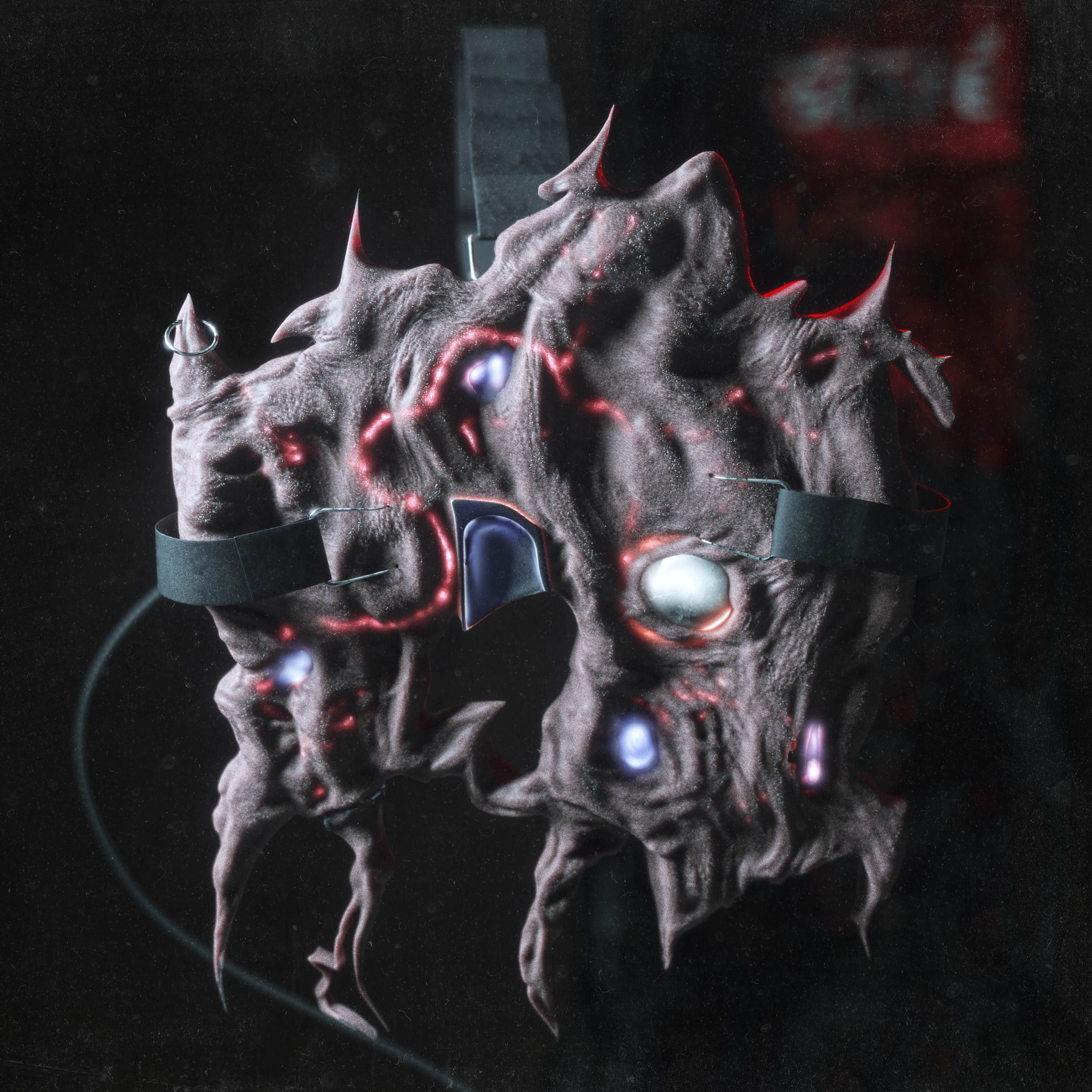
"1_-9,81_VR_Headset" by Oleksandr Martsynyuk
Currently what are the ways you promote your work and upcoming drops?
Sarah Ann Banks / @ssarahbankss: Mostly Instagram, Twitter, and clubhouse!
Irene P Tello / @ip.tello: I promote my work in many different ways but mainly by social media/Instagram as the official channel platform. I also display my artworks on my website ireneptello.eu and Vimeo vimeo.com/iptello. I collaborate and work actively in partnership with digital art platforms and NFT cryptocurrency markets, like Visioni Parallele, Electric Artifacts, Sky Fine Foods, for the right distribution. I’ve also been participating in digital art festivals such as CADAF among others.
Stacie Ant / whosthereplease: I haven't had many drops yet, but in the past to promote my releases or drops, I try to create hype around it. It's also great to get a shoutout from the platform that's releasing the work in order to get more visibility. And I am a big believer in collaborations with other artists and companies, and I believe in strength in numbers.
Dominik Nawrocki / @sesimen.co: Through my IG account and sometimes in Discord.
"-gaXm0n" by Gondris Cavel
@tabithaswanson_: I’ve gotten more into Twitter as I’ve gotten more NFTs and the community there is great, so I always promote my drops on Twitter and in Discord groups I'm part of.
@gondris_cavel: I am always thinking of new ways to communicate my work and ways for it to exist. I think the day-to-day shows more rules. Actions that happen and shape each day, people who connect with you and contacts that are made (virtual or personal).
Guillaume Roux / @rouxcoucou: Insta and Twitter
@530degres: We’re not particularly involved in the NFT world, but we mainly make use of our social networks (Instagram, Twitter).
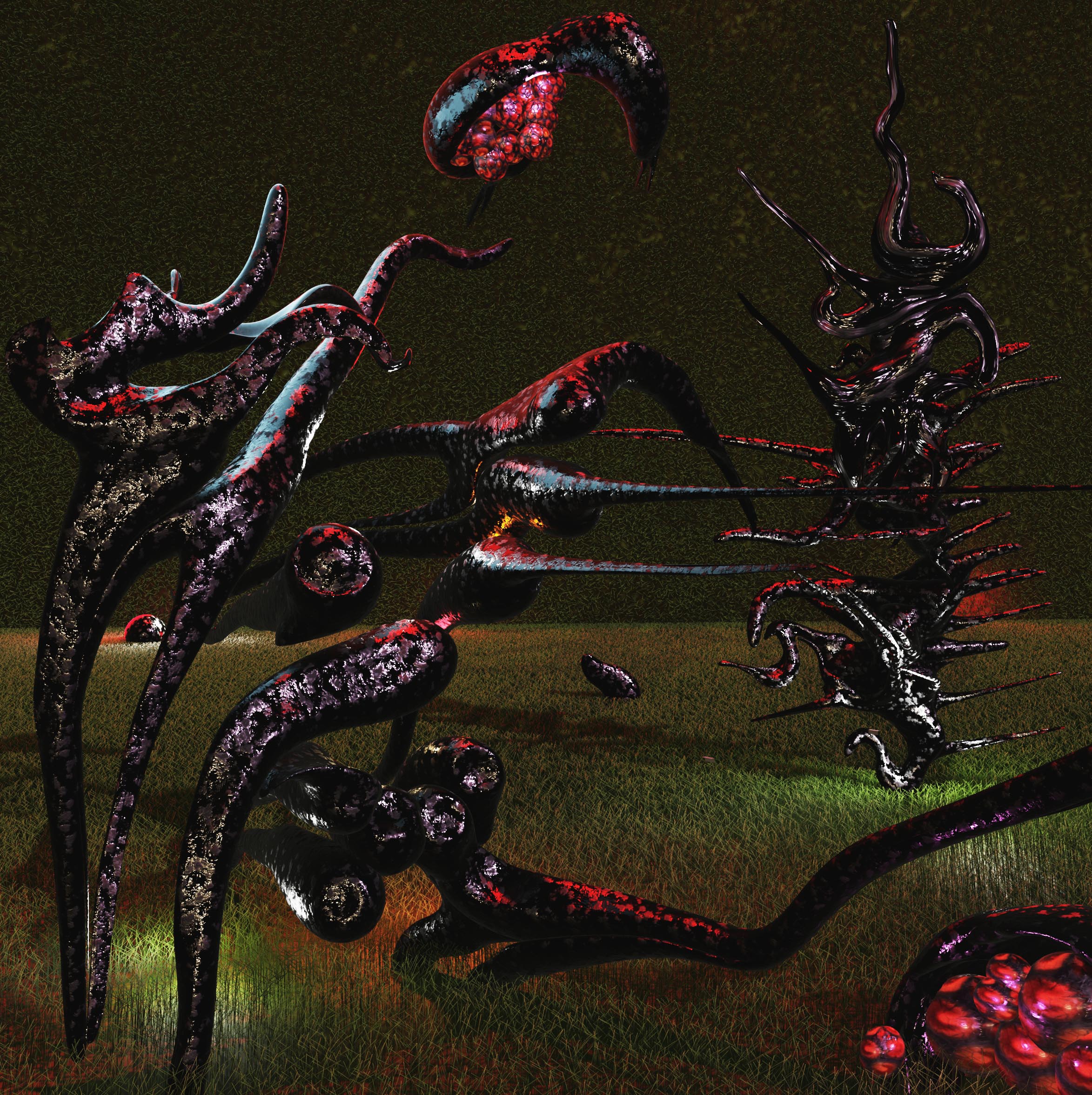
"Coagulo" by Ailin Kertesz
Interview by TUNICA Questions by Emiliano Guevara Curated by Carl Caruana Edited by Therese Nguyen
